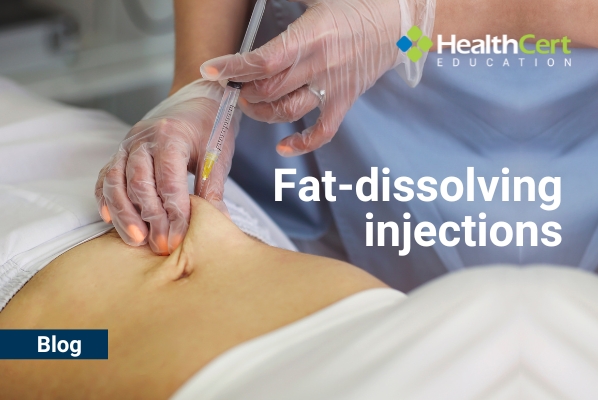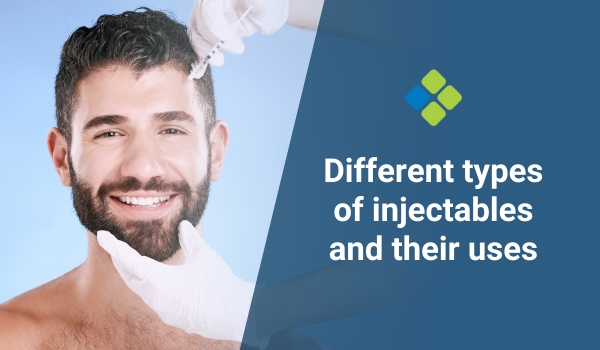Fat-dissolving injections
In aesthetic medicine, fat-dissolving injections (lipolytic injections) can help patients achieve a slimmer and more contoured appearance.

HealthCert Education
As the demand for non-surgical aesthetic treatments continues to rise, more and more primary care practitioners are considering adding cosmetic procedures to their portfolios. One popular area of aesthetic medicine is the use of fat-dissolving injections, also known as lipolytic injections, which can help patients achieve a slimmer and more contoured appearance.
For further information on fat-dissolving injections, you may be interested in the HealthCert online Professional Diploma program in Aesthetic Medicine.
What are fat-dissolving injections?
Fat-dissolving injections are a non-surgical cosmetic treatment that involves injecting a solution into specific areas of the body to dissolve localised pockets of fat. The solution typically contains a combination of compounds that are designed to break down fat cells, such as deoxycholic acid or phosphatidylcholine.
Administration of fat-dissolving injections
The injections are typically administered in a grid-like pattern, with a 1 cm gap between each injection site. The needles are inserted at a 90-degree angle to the skin, and the solution is injected directly into the subcutaneous fat layer. Over time, the fat cells break down and are naturally eliminated from the body.
Fat-dissolving injections are most commonly used to treat areas of stubborn fat that are resistant to diet and exercise, such as the chin, jowls, abdomen, and thighs. The injections are not intended for weight loss and are best suited for patients with a BMI of 30 or below.
It's essential to note that fat-dissolving injections are a medical procedure and should only be administered by a trained and licensed medical professional. Patients should be fully informed of the potential risks and benefits before undergoing treatment.
Guidelines for fat-dissolving injections in primary care
If you're a GP considering adding this treatment to your repertoire, it's essential to understand the guidelines for the safe and effective use of fat-dissolving injections. Here's what you need to know:
Patient selection
Fat-dissolving injections are best suited for patients with localised pockets of fat that are resistant to diet and exercise. These injections are not intended for weight loss, and patients should have a BMI of 30 or below to be considered for treatment.
Product selection
There are two types of fat-dissolving injections available: deoxycholic acid and phosphatidylcholine. Both are effective at breaking down fat cells, but deoxycholic acid is FDA-approved for use on submental fat (the area under the chin), while phosphatidylcholine is commonly used off-label for other areas of the body.
Injection technique
Proper injection technique is critical for achieving optimal results while minimising the risk of adverse effects. The injections should be placed in a grid-like pattern with a 1 cm gap between each injection site, and the needle should be inserted at a 90-degree angle to the skin.
Side effects
While fat-dissolving injections are generally safe, there are some potential side effects that patients should be aware of, including bruising, swelling, and temporary numbness. It's essential to fully inform patients of the potential risks and benefits before administering the injections.
Follow-up
Patients should be closely monitored after treatment, and any adverse effects should be reported to the prescribing physician immediately. Patients should also be advised to avoid alcohol, strenuous exercise, and exposure to heat or cold for a few days after treatment.
If you're interested in offering fat-dissolving injections in your practice, it's crucial to receive proper training and certification. There are many online courses available that can provide you with the knowledge and skills necessary to safely and effectively administer these injections.
Fat-dissolving injections can be a valuable addition to a primary care practice, but it's crucial to follow the guidelines for safe and effective use. By carefully selecting patients, using the appropriate products and injection techniques, and closely monitoring patients after treatment, you can help your patients achieve their aesthetic goals while minimising the risk of adverse effects.
– Dr Rosmy De Barros
For further information on this topic, you may be interested in HealthCert's medical aesthetic training for doctors.
References:
- Anand C. Facial Contouring With Fillers, Neuromodulators, and Lipolysis to Achieve a Natural Look in Patients With Facial Fullness. J Drugs Dermatol. 2016;15(12):1536-1542.
- Farina GA, Cherubini K, de Figueiredo MAZ, Salum FG. Deoxycholic acid in the submental fat reduction: A review of properties, adverse effects, and complications. J Cosmet Dermatol. 2020;19(10):2497-2504. doi:10.1111/jocd.13619
- Pereira JX, Cavalcante Y, Wanzeler de Oliveira R. The role of inflammation in adipocytolytic nonsurgical esthetic procedures for body contouring. Clin Cosmet Investig Dermatol. 2017;10:57-66. Published 2017 Feb 23. doi:10.2147/CCID.S125580
- Gupta J, Kassir M, Kroumpouzos G, et al. Deoxycholic Acid (ATX-101) for Fat Reduction. J Drugs Dermatol. 2021;20(11):1169-1173. doi:10.36849/jdd.3936

 1800 867 1390
1800 867 1390





